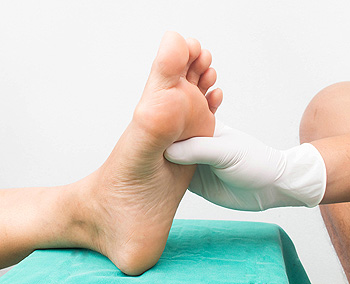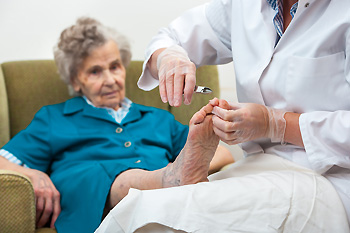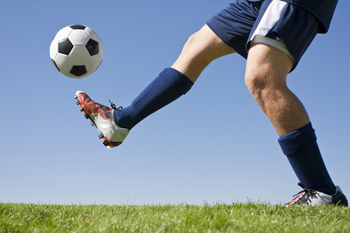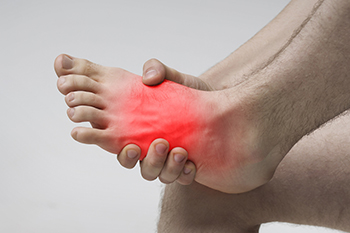Items filtered by date: June 2022
Causes of Peripheral Neuropathy

When the nerves in the extremities – commonly the feet – are damaged, it results in a condition known as peripheral neuropathy. Symptoms include numbness, tingling and burning pain. It can also affect your balance, coordination, and muscle strength. The numbness makes it difficult to notice sores and cuts on your feet that can develop into ulcers, or even gangrene. In rare cases, neuropathy has no recognizable cause, known as idiopathic neuropathy. But the most common cause of peripheral neuropathy is thought to be diabetes. High levels of blood sugar can damage the blood vessels that supply the nerves. The likelihood of developing this condition further increases with age, alcohol use, and smoking. Other factors that may contribute to peripheral neuropathy include low levels of vitamin B12, trauma to the nerves after surgery, an underactive thyroid gland, and genetics. In addition, certain infections, such as shingles, Lyme’s disease, and HIV may be causes as well. If you have peripheral neuropathy, please make an appointment with a podiatrist for regular examinations of your feet and treatment options.
Neuropathy
Neuropathy can be a potentially serious condition, especially if it is left undiagnosed. If you have any concerns that you may be experiencing nerve loss in your feet, consult with one of our podiatrists from Ankle and Foot Centers of Missouri, P.C.. Our doctors will assess your condition and provide you with quality foot and ankle treatment for neuropathy.
What Is Neuropathy?
Neuropathy is a condition that leads to damage to the nerves in the body. Peripheral neuropathy, or neuropathy that affects your peripheral nervous system, usually occurs in the feet. Neuropathy can be triggered by a number of different causes. Such causes include diabetes, infections, cancers, disorders, and toxic substances.
Symptoms of Neuropathy Include:
- Numbness
- Sensation loss
- Prickling and tingling sensations
- Throbbing, freezing, burning pains
- Muscle weakness
Those with diabetes are at serious risk due to being unable to feel an ulcer on their feet. Diabetics usually also suffer from poor blood circulation. This can lead to the wound not healing, infections occurring, and the limb may have to be amputated.
Treatment
To treat neuropathy in the foot, podiatrists will first diagnose the cause of the neuropathy. Figuring out the underlying cause of the neuropathy will allow the podiatrist to prescribe the best treatment, whether it be caused by diabetes, toxic substance exposure, infection, etc. If the nerve has not died, then it’s possible that sensation may be able to return to the foot.
Pain medication may be issued for pain. Electrical nerve stimulation can be used to stimulate nerves. If the neuropathy is caused from pressure on the nerves, then surgery may be necessary.
If you have any questions, please feel free to contact our offices located in the Greater Kansas City area . We offer the newest diagnostic and treatment technologies for all your foot care needs.
It's Time for Beautiful Feet
Caring for Elderly Feet

As people age and the skin loses its thickness and elasticity, it can become harder to take care of their feet. Because it gets harder to bend and inspect elderly feet, caregivers often assume the role of elderly foot care. This can be a daunting task if the one cared for is embarrassed that they cannot do this for themselves and resist help. The key things to look for regarding an older person’s feet are signs of infection, such as discolored nails, blisters, cracked skin, or bleeding sores and wounds. Clean and dry the feet thoroughly each day. Toenails should be kept at a short length to avoid breaking, snagging on clothing, or scratching the skin. Look for ingrown toenails or hangnails, moisturize the feet, and make sure the elderly person wears shoes that fit properly. Footwear should also provide adequate cushioning and support for the feet, and fasten securely. Socks should not be too tight. If circulation is an issue for an older person a warm foot bath might be employed to help with blood flow and relieve tired, achy feet. If infections or problems with an older person’s feet are noted, a quick response and contacting a podiatrist can prevent a foot health crisis. A podiatrist can properly diagnose, treat, and provide prevention tips on caring for elderly feet.
If you need your feet checked, contact one of our podiatrists of Ankle and Foot Centers of Missouri, P.C.. Our doctors will attend to all of your foot and ankle needs and provide you with quality treatment.
Geriatrics and Podiatry
When people age, some common issues that may occur are bone density loss, dry skin, poor circulation, and rough brittle nails. These issues may also affect your foot health if the necessary steps are not taken to alleviate the problems.
It is important to take care of your feet because feet that are injured or diseased can affect your overall health. Having painful feet hinders your ability to do daily activities or may decrease your willingness to do the things that you need to do.
Visiting Your Geriatrician
As we age, health problems become more likely, so it is essential to visit your doctor for check-ups to ensure that you are doing the best you can to take care of your health. It is recommended to check your feet frequently for any possible cuts, bruises, swelling, corns or any other irregularities.
Taking Care of Elderly Feet
Cracked or dry feet can be treated by applying moisturizer often. It is also important not to wear old socks because the older the sock is, the higher the possibility there will be that there is bacteria there. Wear fresh socks and make sure they fit properly.
Proper foot health means that you can have a more active lifestyle and you will not be bogged down by pain. Foot health also leads to good circulation, which is paramount for overall health.
If you have any questions, please feel free to contact our offices located in the Greater Kansas City area . We offer the newest diagnostic tools and technology to treat your foot and ankle needs.
What Is Turf Toe?

Metatarsophalangeal (MTP) joints connect the long metatarsal bones in the forefoot with the proximal phalanges which form at the base of the toes. Athletes such as football players, soccer players, dancers, basketball players, and gymnasts can place excessive force on the MTP joints by repeatedly pushing off and flexing the big toe on harder, artificial surfaces, by changing direction abruptly, or stopping and starting frequently. This constant type of action can cause the ligament under the big toe to hyperextend and lead to an MTP joint sprain in the big toe, commonly referred to as turf toe. Turf toe symptoms include pain, swelling, instability, stiffness, and limited movement in the big toe that worsens when you put pressure on it or extend it. Turf toe can develop over time or may be the result of a sudden injury—at which point a popping sensation may be felt. If you are experiencing any of the symptoms described here, it is wise to schedule an appointment with a podiatrist to be properly diagnosed and treated.
Sports related foot and ankle injuries require proper treatment before players can go back to their regular routines. For more information, contact one of our podiatrists of Ankle and Foot Centers of Missouri, P.C.. Our doctors can provide the care you need to keep you pain-free and on your feet.
Sports Related Foot and Ankle Injuries
Foot and ankle injuries are a common occurrence when it comes to athletes of any sport. While many athletes dismiss the initial aches and pains, the truth is that ignoring potential foot and ankle injuries can lead to serious problems. As athletes continue to place pressure and strain the area further, a mild injury can turn into something as serious as a rupture and may lead to a permanent disability. There are many factors that contribute to sports related foot and ankle injuries, which include failure to warm up properly, not providing support or wearing bad footwear. Common injuries and conditions athletes face, including:
- Plantar Fasciitis
- Plantar Fasciosis
- Achilles Tendinitis
- Achilles Tendon Rupture
- Ankle Sprains
Sports related injuries are commonly treated using the RICE method. This includes rest, applying ice to the injured area, compression and elevating the ankle. More serious sprains and injuries may require surgery, which could include arthroscopic and reconstructive surgery. Rehabilitation and therapy may also be required in order to get any recovering athlete to become fully functional again. Any unusual aches and pains an athlete sustains must be evaluated by a licensed, reputable medical professional.
If you have any questions please feel free to contact our offices located in the Greater Kansas City area . We offer the newest diagnostic and treatment technologies for all your foot and ankle needs.
Synovial Joint Pain in the Feet

The foot consists of 34 joints, all of which contain synovial membranes. When these membranes become inflamed, the result is swelling, redness, and pain when you move. This condition, known as synovitis, is common among athletes who are involved in repetitive stress movements like lifting and squatting. Patients with rheumatoid arthritis, juvenile arthritis, lupus, and psoriatic arthritis may also experience synovitis. In these cases, excessive growth of the synovial membrane is part of an autoimmune response where the body attacks itself. The cells then release enzymes into the synovial capsule of the joint causing further inflammation and pain. Depending on the cause, pain from synovitis can be short-lived or continued. If you are experiencing frequent joint pain or inflammation of the feet and ankles, it is suggested to check with a podiatrist for a complete examination and proper diagnosis.
Because RA affects more than just your joints, including the joints in your feet and ankles, it is important to seek early diagnosis from your podiatrist if you feel like the pain in your feet might be caused by RA. For more information, contact one of our podiatrists of Ankle and Foot Centers of Missouri, P.C.. Our doctors will assist you with all of your podiatric concerns.
What Is Rheumatoid Arthritis?
Rheumatoid Arthritis (RA) is an autoimmune disorder in which the body’s own immune system attacks the membranes surrounding the joints. Inflammation of the lining and eventually the destruction of the joint’s cartilage and bone occur, causing severe pain and immobility.
Rheumatoid Arthritis of the Feet
Although RA usually attacks multiple bones and joints throughout the entire body, almost 90 percent of cases result in pain in the foot or ankle area.
Symptoms
- Swelling and pain in the feet
- Stiffness in the feet
- Pain on the ball or sole of feet
- Joint shift and deformation
Diagnosis
Quick diagnosis of RA in the feet is important so that the podiatrist can treat the area effectively. Your doctor will ask you about your medical history, occupation, and lifestyle to determine the origin of the condition. Rheumatoid Factor tests help to determine if someone is affected by the disease.
If you have any questions please feel free to contact our offices located in the Greater Kansas City area . We offer the newest diagnostic and treatment technologies for all your foot and ankle needs.

